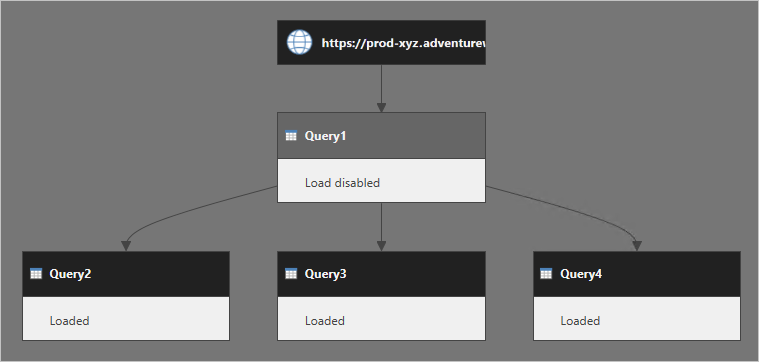Note
Access to this page requires authorization. You can try signing in or changing directories.
Access to this page requires authorization. You can try changing directories.
This article targets you as a data modeler working with Power BI Desktop. It provides you with guidance when defining Power Query queries that reference other queries.
Let's be clear about what this means: When a query references a second query, it's as though the steps in the second query are combined with, and run before, the steps in the first query.
Scenario
Consider several queries: Query1 sources data from a web service, and its load is disabled. Query2, Query3, and Query4 all reference Query1, and their outputs are loaded to the data model.

When the data model is refreshed, it's often assumed that Power Query retrieves the Query1 result, and that it's reused by referenced queries. This thinking is incorrect. In fact, Power Query executes Query2, Query3, and Query4 separately.
You can think that Query2 has the Query1 steps embedded into it. It's the case for Query3 and Query4, too. The following diagram presents a clearer picture of how the queries are executed.

Query1 is executed three times. The multiple executions can result in slow data refresh and negatively impact the data source.
The use of the Table.Buffer function in Query1 won't eliminate the additional data retrieval. This function buffers a table to memory, and the buffered table can only be used within the same query execution. So, in the example, if Query1 is buffered when Query2 is executed, the buffered data couldn't be used when Query3 and Query4 are executed. They themselves will buffer the data twice more. (This result could in fact compound the negative performance, because the table will be buffered by each referencing query.)
Note
Power Query caching architecture is complex, and it's not the focus of this article. Power Query can cache data retrieved from a data source. However, when it executes a query, it may retrieve the data from the data source more than once.
Recommendations
Generally, we recommend you reference queries to avoid the duplication of logic across your queries. However, as described in this article, this design approach can contribute to slow data refreshes and overburden data sources.
We recommend you create a dataflow instead. Using a dataflow can improve data refresh time and reduce impact on your data sources.
You can design the dataflow to encapsulate the source data and transformations. As the dataflow is a persisted store of data in the Power BI service, its data retrieval is fast. So, even when referencing queries result in multiple requests for the dataflow, data refresh times can be improved.
In the example, if Query1 is redesigned as a dataflow entity, Query2, Query3, and Query4 can use it as a data source. With this design, the entity sourced by Query1 will be evaluated only once.
Related content
For more information related to this article, check out the following resources: